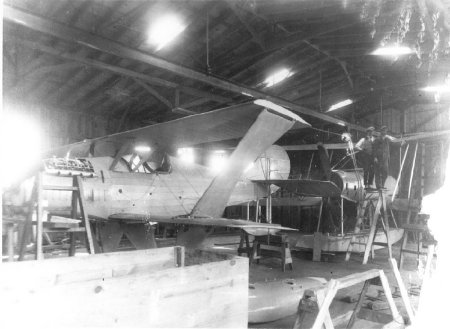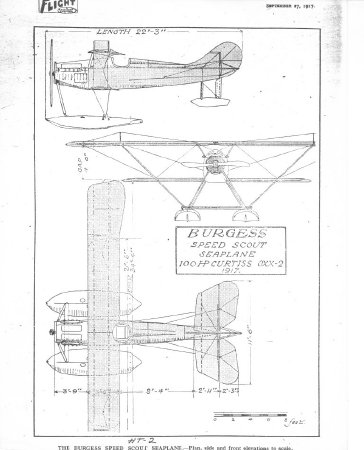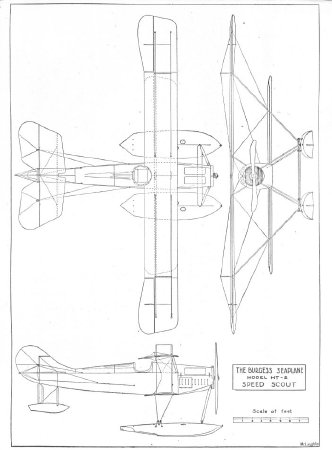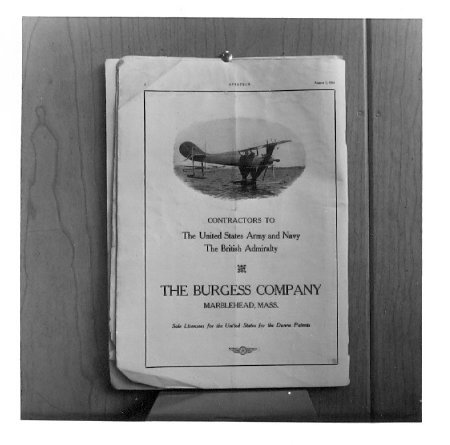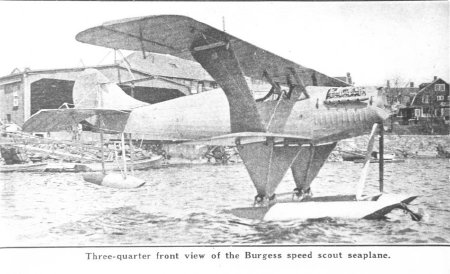Object ID:
2015.11.61
VE Exhibit Label 1:
Model HT-1 Speed Scout
The Burgess Company Model HT-1 Speed Scout was a sesquiplane tractor biplane on twin floats. It was designed by Burgess and 2 were built at a price of $13,000 each. Type A and Type B small Speed Scout seaplane prototypes designed for a U.S.N. specification dated November 17, 1916 required a speed of 50-95 mph with an endurance of 2.5 hours. Their mission was to perform strategic reconnaissance beyond the range of current fleet observation capability with a minimum patrol range of 100 miles. The specification also assumed that HT aeroplanes would be equipped with the light weight Gnome 100 hp rotary engine.
Two distinct Speed Scout models were built - the HT-1 Type A and the HT-1 Type B. The first flights were made by Ellwood "Gink" Doherty on May 19, 1917. After analysis of the flight testing was completed, two HT-1s were ordered on May 22, 1917 using the type B as the standard. Thus the HT-1 Type A was to be converted to a Type B before delivery to the U.S. Navy. The first modified aircraft A-155 was delivered to the Navy at Squantum on September 11, 1917 and the second A-156 was scheduled to be shipped to Pensacola during October 1917.
The Model HT-1 was a single place with foldable wings that could be reduced fro 28' to 22' for shipboard storage. It was powered by a Curtiss OXX2 V-8 100 hp engine with a speed range of 57-80/85 mph and a landing speed of 50 mph. It had a span of 28', a fuel capacity for two hours, and a gross weight of 1779 lbs that reduced to 1,652 lbs after modifications. Its wing area was 200 sq ft.
Gnome engines could not be obtained and the Burgess designs were thus handicapped in performance. The Navy recognized the fact that weight of the Curtiss vs. the Gnome engine made it impossible to meet the original requirements for a swift and wind ranging "Speed Scout". Navy contact officers believed that the HT aircraft were good solid designs and would be useful as advanced seaplane trainers and they purchased them for that roll.
The HT-1 A-155 wrecked beyond repair at Squantum on October 4, 1917. HT-1 A-156 for unstated reasons remained incomplete and was eventually sent to the MIT Ground School and written off the Navy List on January 4, 1919. Perhaps the completion of the HT-2 production models in November 1917 preempted the need to spend money rebuilding the second HT-1 to the new specifications. The U.S. Navy Serial numbers were #A-155 and #A-156.
Model HT-2 Speed Scout
The Burgess Company Model HT-2 Speed Scout was a single place sesquiplane tractor biplane on twin floats. It was the HT-1B Twin design with modifications and improvements. It was ordered on May 22, 1917 and delivered to the U.S.N in November 1917. There were six built, each at a price of $13,000. Flight testing was done by Elwood "Gink" Doherty in August through October 1917.
The Model HT-2 was powered by a Curtiss OXX2 V-8 100 hp engine with a 7'9" propeller. Its minimum speed was 50 mph, maximum speed was 95 mph with an endurance of 2.5 hours. There was no dihedral, no sweepback and no stagger of the wings. The upper span was 34'4", lower span 21'6", height 10', length 22'3", chord 3'6", and gap 4'6". It had a Deperdussin control system. Model HT-2 last left Navy service in May 1921. Its U.S. Navy Serial numbers included #A-374 through A-379.
The Burgess Company Model HT-1 Speed Scout was a sesquiplane tractor biplane on twin floats. It was designed by Burgess and 2 were built at a price of $13,000 each. Type A and Type B small Speed Scout seaplane prototypes designed for a U.S.N. specification dated November 17, 1916 required a speed of 50-95 mph with an endurance of 2.5 hours. Their mission was to perform strategic reconnaissance beyond the range of current fleet observation capability with a minimum patrol range of 100 miles. The specification also assumed that HT aeroplanes would be equipped with the light weight Gnome 100 hp rotary engine.
Two distinct Speed Scout models were built - the HT-1 Type A and the HT-1 Type B. The first flights were made by Ellwood "Gink" Doherty on May 19, 1917. After analysis of the flight testing was completed, two HT-1s were ordered on May 22, 1917 using the type B as the standard. Thus the HT-1 Type A was to be converted to a Type B before delivery to the U.S. Navy. The first modified aircraft A-155 was delivered to the Navy at Squantum on September 11, 1917 and the second A-156 was scheduled to be shipped to Pensacola during October 1917.
The Model HT-1 was a single place with foldable wings that could be reduced fro 28' to 22' for shipboard storage. It was powered by a Curtiss OXX2 V-8 100 hp engine with a speed range of 57-80/85 mph and a landing speed of 50 mph. It had a span of 28', a fuel capacity for two hours, and a gross weight of 1779 lbs that reduced to 1,652 lbs after modifications. Its wing area was 200 sq ft.
Gnome engines could not be obtained and the Burgess designs were thus handicapped in performance. The Navy recognized the fact that weight of the Curtiss vs. the Gnome engine made it impossible to meet the original requirements for a swift and wind ranging "Speed Scout". Navy contact officers believed that the HT aircraft were good solid designs and would be useful as advanced seaplane trainers and they purchased them for that roll.
The HT-1 A-155 wrecked beyond repair at Squantum on October 4, 1917. HT-1 A-156 for unstated reasons remained incomplete and was eventually sent to the MIT Ground School and written off the Navy List on January 4, 1919. Perhaps the completion of the HT-2 production models in November 1917 preempted the need to spend money rebuilding the second HT-1 to the new specifications. The U.S. Navy Serial numbers were #A-155 and #A-156.
Model HT-2 Speed Scout
The Burgess Company Model HT-2 Speed Scout was a single place sesquiplane tractor biplane on twin floats. It was the HT-1B Twin design with modifications and improvements. It was ordered on May 22, 1917 and delivered to the U.S.N in November 1917. There were six built, each at a price of $13,000. Flight testing was done by Elwood "Gink" Doherty in August through October 1917.
The Model HT-2 was powered by a Curtiss OXX2 V-8 100 hp engine with a 7'9" propeller. Its minimum speed was 50 mph, maximum speed was 95 mph with an endurance of 2.5 hours. There was no dihedral, no sweepback and no stagger of the wings. The upper span was 34'4", lower span 21'6", height 10', length 22'3", chord 3'6", and gap 4'6". It had a Deperdussin control system. Model HT-2 last left Navy service in May 1921. Its U.S. Navy Serial numbers included #A-374 through A-379.
